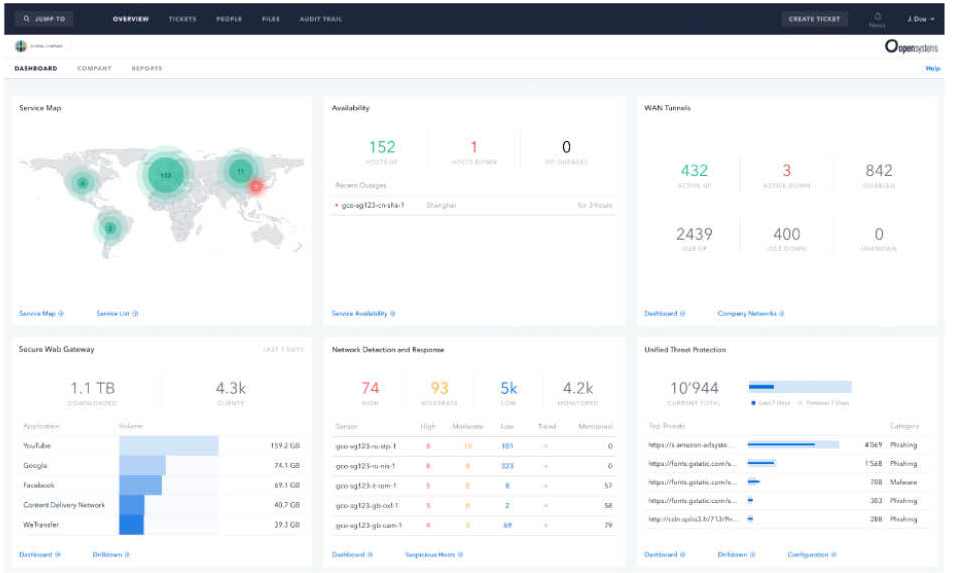
What is Application Performance Management?
Application performance is a crucial metric when designing and measuring the quality of an SD-WAN. Users expect a reliable and fast user interface. Slow performing applications and connections result in reduced user productivity, or worse, customers leaving your service and moving to a competitor. In some cases, performance and reliability are critical. For applications such as online trading, security services, remote healthcare, voice and video conferencing, and emergency response having a slow connection isn’t just a nuisance; it’s a disaster.
Analyzing and Overcoming
Performance Challenges
Server Performance
Sluggish application performance can be attributed to problems at the server layer such as an underpowered CPU, limited memory, slow storage I/O, resource-hungry code, poorly configured virtualization, excessive logging, or too many back-ground processes.
Network Performance
Poor network performance can be caused by limited bandwidth, line saturation, broken routing tables, switch configurations, or poorly implemented cybersecurity.
Download our latest eBook. This new approach to networking comprises a set of truly integrated, cloud-managed security services delivered on-prem or in the cloud with centrally managed security. Learn how to:
- Reduce complexity and operational overhead
- Deliver ease of use/transparency for users
- Enhance security with zero-trust network access

Leading vendors, such as Open Systems, provide a complete end-to-end solution. The unified management console includes comprehensive performance monitoring, optimization, and management across the entire network stack, from the core – to cloud – to edge
Open Systems provides one homogeneous view of the entire network, including the traffic loads and patterns for various applications. Embedded Open Systems technology analyses and identifies what type of traffic is passing through the network. It classifies the traffic and associates it with multiple types of applications. It can also be configured to identify unique customer applications that require high levels of performance and priority-routing.

Ensure User Experience is Maintained
Network performance is continually monitored for various applications to ensure the quality of service requirements are met. In the rare event an application service falls below the pre-configured performance threshold, Open Systems invokes mechanisms to ensure the user experience is maintained. Some of these mechanisms include,
- Technology that monitors application and network loads
- Can analyze traffic to determine the application classification or custom applications
- Make intelligent decisions to delay traffic or reroute traffic to lower or higher-performing paths as needed
Load Balancing
Network load balancing, also known as multi-homing or dual-WAN routing, allows the SD-WAN to balance traffic across multiple network links. The SD-WAN monitors and knows the utilization levels of all connections. If an application or network link is experiencing increased connection latency, the load can be shared across other available links to ensure service levels are met. Links do not need to be the same for load-balancing. As an example, if a customer is using a 45mbps WAN link and a 20mbps broadband link, they can be used to share the application load. The usable bandwidth is now 65mbps, allowing application performance levels to meet the quality of service requirements.
Traffic Shaping
Packet or traffic shaping delays traffic flow from low priority applications so that high priority traffic, such as OLTP, maintains the required quality of service. This is possible if the SD-WAN has,
Failover
In the rare event, a connection or device suffers a disruption, the SD-WAN will automatically move the traffic to an alternative route. This ensures continuous access to critical applicators and maintains the quality of service.
Network load balancing, also known as multi-homing or dual-WAN routing, allows the SD-WAN to balance traffic across multiple network links. The SD-WAN monitors and knows the utilization levels of all connections. If an application or network link is experiencing increased connection latency, the load can be shared across other available links to ensure service levels are met. Links do not need to be the same for load-balancing. As an example, if a customer is using a 45mbps WAN link and a 20mbps broadband link, they can be used to share the application load. The usable bandwidth is now 65mbps, allowing application performance levels to meet the quality of service requirements.
Packet or traffic shaping delays traffic flow from low priority applications so that high priority traffic, such as OLTP, maintains the required quality of service. This is possible if the SD-WAN has,
- Technology that monitors application and network loads
- Can analyze traffic to determine the application classification or custom applications
- Make intelligent decisions to delay traffic or reroute traffic to lower or higher-performing paths as needed
In the rare event, a connection or device suffers a disruption, the SD-WAN will automatically move the traffic to an alternative route. This ensures continuous access to critical applicators and maintains the quality of service.
Open Systems removes the tedious configuration and guesswork out of network management. It adds an intelligent and autonomous layer that manages network configuration to ensure QoS levels are met and costs are contained.
Contact our customer advocates to learn how to optimize performance while reducing management complexity and costs.


Leave Complexity
Behind
To learn how Open Systems SASE Experience can benefit your organization, talk to a specialist today.
Contact Us



